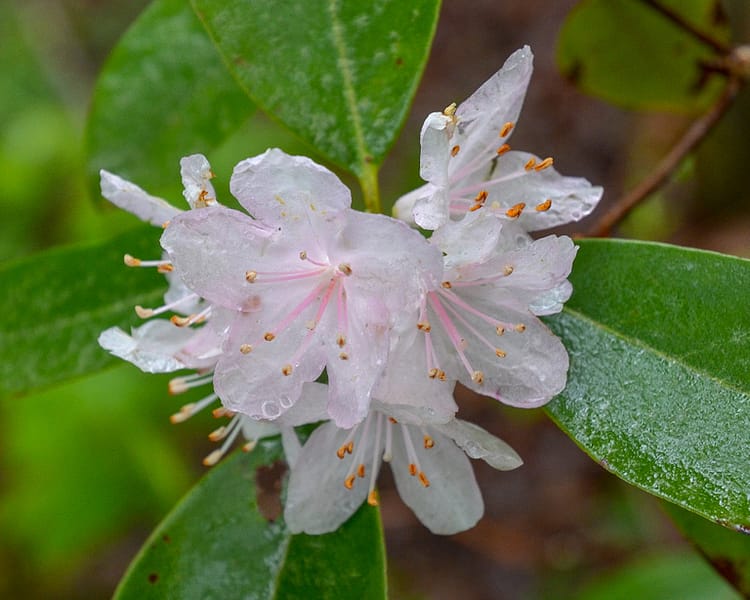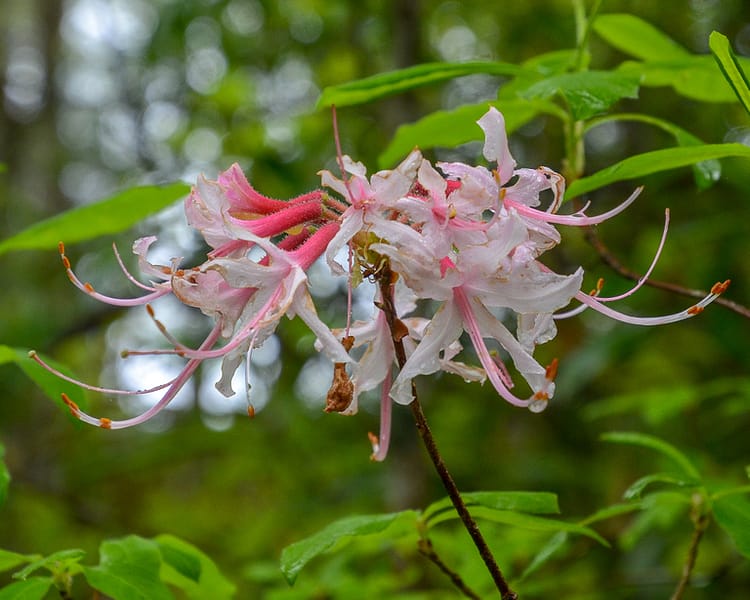The Blue Ridge escarpment is always a tantalizing area that promises earlier wildflowers, waterfalls, hiking trails, and a variety of plant communities. Our first destination to revisit was the Ashmore Heritage Preserve off Route 276 in South Carolina. Pisgah National Forest in North Carolina was our final destination for the day. All in all, we hiked a total of 7.5 wet, and often chilly, miles.
Spring continues to unfold, marked by fickle weather that ranges from mid 70’s to near freezing temperatures. This region has experienced record-setting rain, and flooding squeezed in for good measure. However, the upside of the rain is that waterfalls are at their peak volume.

Despite the rain, it was a three-day weekend for me, and I wanted to camp and hike for at least two days. Unfortunately, those plans did not come to fruition. Friday was nothing less than a deluge. Those who live close to rivers and tributaries were on high alert.
Adaptability is the key; shifting our plans to staging and organizing for future hikes. (Translation: get your sh*t together at home so you can spend more time in the woods.) Nonetheless, it was not raining first thing Saturday morning, so we decided to get out there.
Blue Ridge Escarpment: Get out there!
The Ashmore Heritage Preserve in South Carolina never fails to meet expectations, and early spring holds many delights. Many thanks to Jim Fowler; his knowledge and photographs bring wildflowers and their habitats to life: http://www.jfowlerphotography.com/.

After four years of visiting this area, one would think that I would remember the trails. I remember the wildflowers in striking detail; the specific trails, not so much. As a result, we explored more trails and it was AWESOME! There are so many dazzling areas in the escarpment in addition to the Ashmore Heritage Preserve: https://hikescape.org/blue-wall-preserve/

Waterfalls galore…
Once on the trail, we turned toward Lake Wattaccoo, but retraced our steps to the Oil Camp trail. Thankfully, we were prepared for rain, as intermittent showers persisted. Devil’s bit was in bloom, and this particular patch was located off the trail and down a steep embankment.

I climbed back up the bank and encountered the only other hiker for the entire day. As we proceeded up the Oil Camp trail, there were two waterfalls, one formed from two streams meeting over a large expanse of rock, and the other cascading over a steeper incline.

One goal for the day was to locate pink lady’s slipper and assess their stage of bloom. In the process, we also wanted to get a few miles in, rain or not. On our trek back to Lake Wattaccoo, Bernie spotted a cascading waterfall high above the lake. This, of course, was an invitation for exploration.

Despite platinum- colored skies, we climbed up towards the waterfall, carefully securing our footing through the rhododendron and boulders. (NOTE: each year, people attempt to climb to the top of waterfalls in our region, often with deadly results. We remained on soil the entire time, and enjoyed the view from a safe distance.)

In search of the waterfall
We reached the bottom of the portion of the waterfall that was visible from the lake. Above us, there were a couple of tiered waterfall sections. The water raced down the rock face in layers, forming a fast-moving chute as the stream zig-zagged downward. We stood silently, listening to the sound of the water and taking in the greenery all around us. What a perfect day on the Blue Ridge escarpment…
Here is more information about the terrain and features of the Blue Ridge escarpment: http://southernappalachianvitalityindex.org/land/terrain-and-elevation

“All the larger streams of uncultivated countries are mysteriously charming and beautiful, whether flowing in mountains or through swamps and plains. Their channels are interestingly sculptured, far more so than the grandest architectural works of man. The finest of the forests are usually found along their banks, and in the multitude of falls and rapids the wilderness finds a voice.”
John Muir, A Thousand-Mile Walk to the Gulf
Catesby’s trillium and Pink Lady’s slipper
Score! The pink lady’s slipper orchid was in early bloom at Ashmore Heritage Preserve. The Catesby’s trillium, however, was abundant in both beauty and frequency, so it was a win-win all the way around.





Driving back up to Route 276 to the Pisgah National Forest in North Carolina, with hopes that the Helonias bullata (Swamp Pink) was in bloom. No such luck, but that just means yet another foray into the forest. Hooray!
Our day concluded at Oscar Blues brewery in Brevard, celebrating another stellar day on the trail with a beer and a burger. Happy Trails to you!


